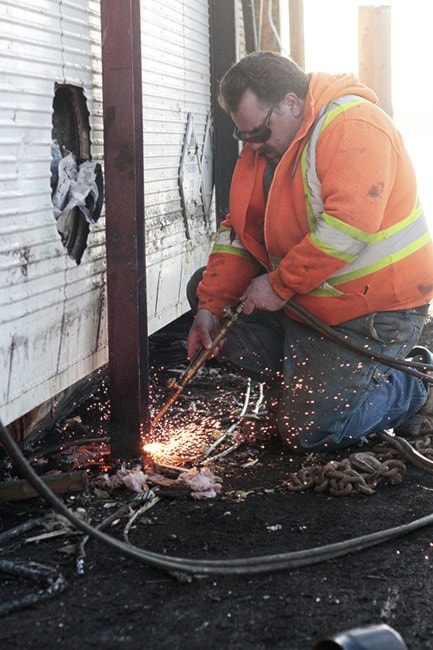Sparks were flying in Masset Harbour last week as workers tore down the top half of a derelict barge.
B.C.’s lands ministry says it will post a contract to scrap the rest — a 38-metre steel hull — in the next few weeks.
Masset Mayor Andrew Merilees welcomed the news, calling the derelict barge a “horrible eyesore.”
But it’s only the most obvious example of a bigger problem, he said, given the hundreds of derelict vessels along the B.C. coast.
Dumped in November 2009 on the foreshore of a small inlet behind the Masset seaplane dock, the barge changed hands multiple times and was eventually salvaged for parts and equipment.
The province has so far been unable to get any of its owners to pay for its clean-up.
“Basically, every time the government goes to force somebody into action, they sell it and say, ‘Oh, I’m not responsible,’” said Merilees.
“That’s why it’s just dragged on and on, and ultimately it’s going to be the province and the taxpayer who are going to have to clean up this mess.”
A spokesperson for B.C.’s Ministry of Lands, Forests, and Natural Resource Operations said they are still seeking legal action under the Lands Act, and actively investigating the case.
Masset councillors raised the barge issue with provincial officials over a year ago. The province posted a bid to remove it this fall, but got no takers.
Cam Campbell, a local contractor on Haida Gwaii, won a more recent bid to remove everything above the barge deck, which had storage and living quarters that were at one time intended for a fishing lodge.
“I’ve heard nothing but positive comments,” said Campbell, standing on the nearly empty barge last Thursday after carefully maneuvering an excavator up a makeshift gravel ramp and driving it switchback-style across the rusting deck.
“The I-beams that run down the middle are in good shape, but everything else is garbage,” he said.
“If I turn sideways, I’m going to go through.”

Campbell said the barge will never float again — its hull is too full of holes.
Getting rid of it will likely mean outfitting an excavator with big steel shears and slicing it into pieces that can be trucked to landfill, he said.
Shipping it to a recycling plant would likely cost much more than the metal is worth.
“I’ll be bidding on it, but it’s a pretty daunting project,” said Campbell.
Merilees noted that there are other, smaller derelict boats and boat trailers in the nearby Masset marina, where the village plans to upgrade the public boat ramp and improve access to the seaplane dock.
Further south, Masset Inlet has several derelict boats on the shore and a large metal structure grounded in the middle.
A map of Haida Gwaii made by the Marine Planning Partnership for the North Pacific Coast shows five derelict vessels in Masset, two in Naden Harbour, one in Rennell Sound, two on Kuper Island, two in Bearskin Bay, and one at Dead Tree Point.
Canada’s Ministry of Transport estimates there are between 600 and 700 derelict vessels across the country.
